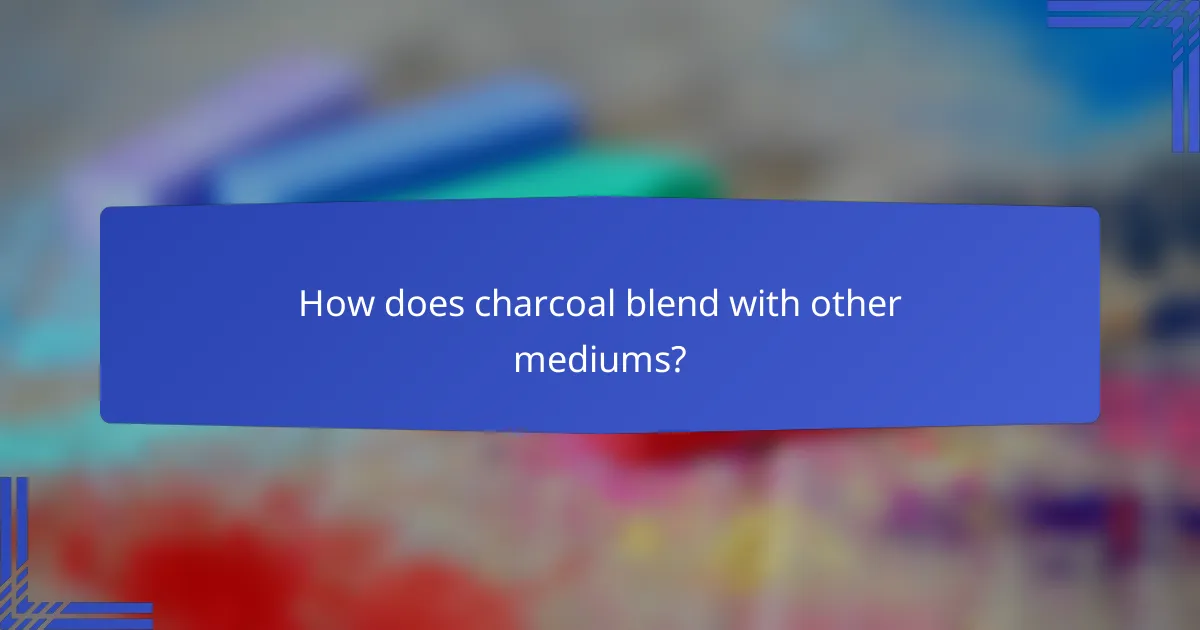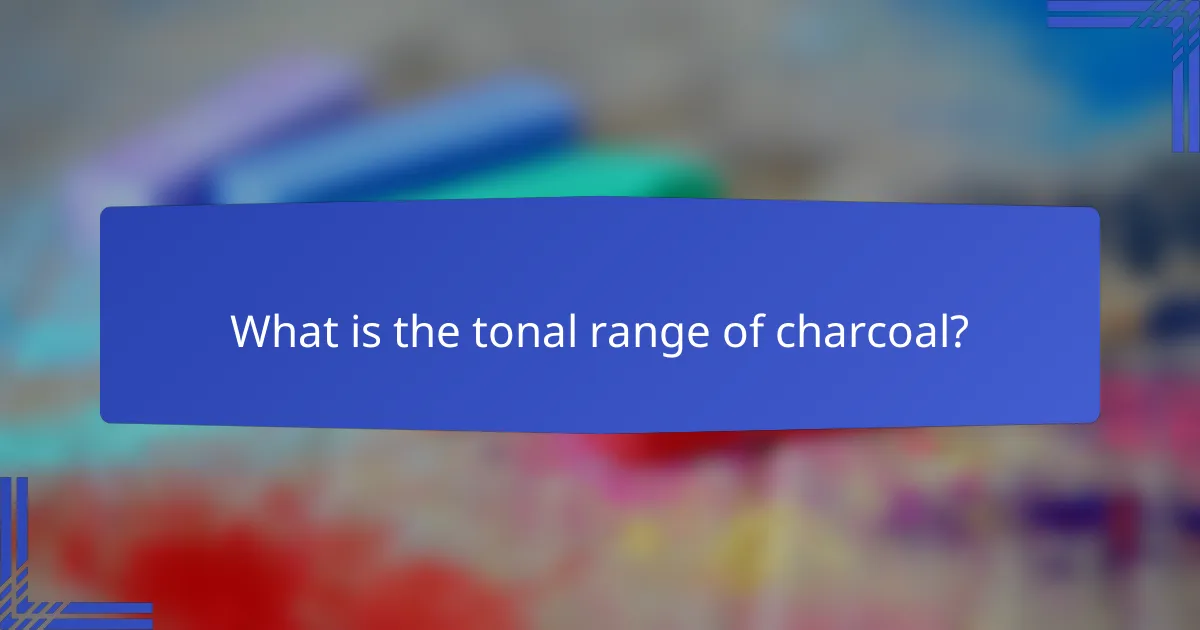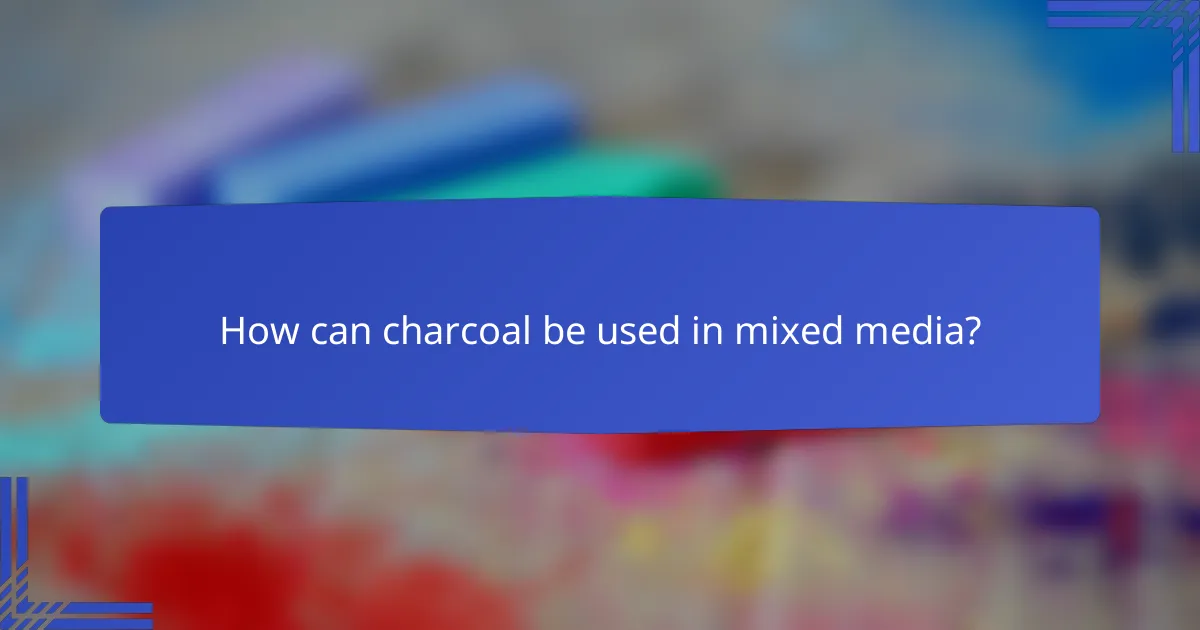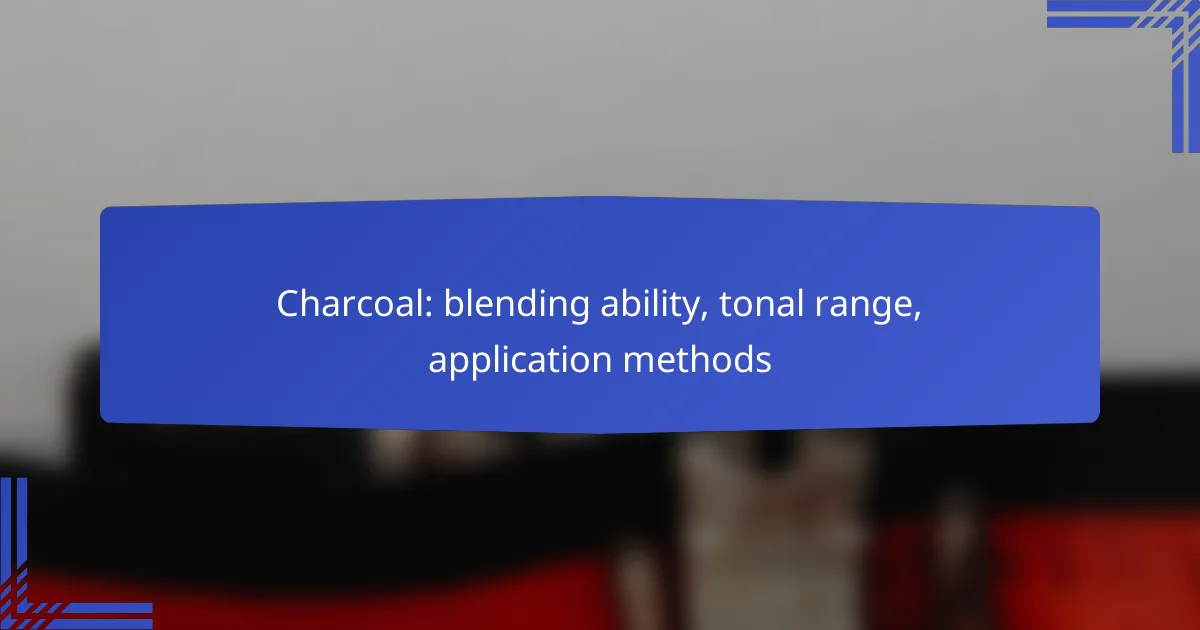Charcoal is a versatile medium that blends seamlessly with various art materials, allowing artists to achieve rich textures and depth in their work. Its tonal range, from deep blacks to soft grays, enables the creation of intricate effects and a wide array of artistic expressions. By employing different application methods such as drawing, shading, and blending, artists can fully exploit charcoal’s potential to enhance their creations.

How does charcoal blend with other mediums?
Charcoal blends effectively with various art mediums, enhancing texture and depth in artwork. Its ability to combine with other materials allows artists to create a wide tonal range and intricate effects.
Compatibility with graphite
Charcoal and graphite can be used together to achieve a rich contrast in tonal values. Graphite provides a smooth, reflective quality, while charcoal adds depth and texture. When blending these two, start with graphite for fine details and layer charcoal for shading and bold strokes.
To ensure compatibility, use a soft charcoal that can easily blend with the smoother graphite. A common approach is to apply graphite first, followed by charcoal, and then blend with a blending stump or finger for a seamless transition.
Mixing with pastels
Charcoal pairs well with pastels, offering a unique combination of soft color and deep shadows. When using both, apply charcoal first to establish the darker areas, then layer pastels on top for vibrant highlights and colors.
To maintain the integrity of both mediums, use fixative sparingly after applying pastels, as too much can muddy the charcoal. Experiment with different pastel brands to find those that adhere well to charcoal without smudging.
Combining with ink
Combining charcoal with ink can create striking contrasts and dynamic compositions. Use charcoal for initial sketches or shading, then apply ink for defined lines and details. This method allows for both fluidity and structure in your artwork.
When working with ink, consider using waterproof ink to prevent smudging when applying charcoal afterward. Alternatively, use charcoal first and then ink to outline or add details, ensuring that the ink dries completely before adding charcoal.
Layering techniques
Layering techniques with charcoal involve building up tones gradually to achieve depth and dimension. Start with light applications of charcoal, gradually increasing pressure for darker areas. This method allows for better control over the final appearance.
Use a variety of tools, such as brushes or sponges, to apply and blend charcoal layers. Avoid overworking the surface, as this can lead to a muddy appearance. Instead, build layers slowly and allow each layer to set before adding more for a refined finish.

What is the tonal range of charcoal?
The tonal range of charcoal spans from deep, rich blacks to soft, light grays. This versatility allows artists to create a wide array of effects and textures, making charcoal a popular medium for drawing and sketching.
Light to dark spectrum
The light to dark spectrum of charcoal is one of its most appealing features. Artists can achieve a full range of tones by varying the application technique, from light smudges to bold strokes. Typically, the darkest tones are achieved with compressed charcoal, while vine charcoal offers softer, lighter shades.
To effectively utilize this spectrum, consider starting with lighter tones and gradually building up to darker shades. This approach helps maintain control over the tonal balance in your artwork.
Variations in hardness
Charcoal comes in various hardness levels, which significantly influence the tonal range. Hard charcoal produces fine lines and lighter shades, while soft charcoal allows for deeper, darker tones and broader strokes. The hardness is often indicated on the packaging, with softer charcoals labeled as B (for black) and harder ones as H.
Choosing the right hardness depends on the desired effect. For detailed work, opt for harder charcoal, while for expressive, bold pieces, soft charcoal is preferable.
Impact of pressure on tone
The pressure applied during drawing directly affects the tone produced with charcoal. Light pressure yields softer, lighter tones, while increased pressure results in darker, more intense marks. This relationship allows artists to create dynamic contrasts within their work.
Experimenting with pressure can enhance your control over tonal variation. Practice applying different levels of pressure to see how it impacts your drawings, and consider using a blending tool to smooth transitions between tones.

What are the application methods for charcoal?
Charcoal can be applied using various methods that enhance its versatility in art. The primary techniques include drawing, shading, and blending, each offering unique effects and textures.
Drawing techniques
Drawing with charcoal involves using the stick or pencil to create lines and shapes on paper. Artists can achieve different line qualities by varying pressure; light pressure yields fine lines, while heavy pressure produces bold strokes. Experimenting with different types of charcoal, such as compressed or vine, can also affect the outcome.
For detailed work, consider using charcoal pencils for precision. For broader strokes, utilize larger pieces of charcoal. Always choose a suitable paper that can handle the texture and weight of charcoal, such as a heavier drawing paper or textured surfaces.
Shading methods
Shading with charcoal allows for a wide tonal range, from deep blacks to soft grays. Techniques such as hatching, cross-hatching, and stippling can create depth and dimension. Layering charcoal gradually builds up darker areas, while erasing can highlight lighter sections.
To achieve smooth transitions, use a blending stump or your fingers to smudge the charcoal gently. Be cautious not to over-blend, as this can lead to a muddy appearance. Practice controlling the pressure applied during shading to maintain a clean and refined look.
Blending tools
Blending tools enhance the smoothness and depth of charcoal applications. Common tools include blending stumps, tortillons, and even soft cloths. Each tool produces different effects; for instance, a blending stump is ideal for fine details, while a cloth can cover larger areas quickly.
When using blending tools, start with light pressure to avoid removing too much charcoal. Keep tools clean to prevent unwanted smudging of colors. Experiment with various tools to discover which best suits your style and the specific effects you wish to achieve.

What factors influence charcoal selection?
Charcoal selection is influenced by several key factors, including the type of charcoal, the intended artwork style, and the compatibility with the drawing surface. Understanding these elements helps artists choose the right charcoal for their projects, ensuring optimal results.
Type of charcoal
There are various types of charcoal, each offering distinct characteristics. Compressed charcoal provides a darker, more intense mark, while vine charcoal is softer and easier to erase, making it ideal for sketching. Artists often choose between these types based on the desired effect and control needed in their work.
Additionally, charcoal pencils combine the convenience of a pencil with the rich texture of charcoal, allowing for precise lines and shading. Experimenting with different types can help artists find their preferred medium.
Intended artwork style
The intended artwork style significantly impacts charcoal selection. For detailed realism, artists may prefer compressed charcoal for its ability to create fine lines and deep shadows. In contrast, for expressive or abstract styles, softer vine charcoal allows for broader strokes and blending.
Artists should consider their style’s requirements, as some techniques may benefit from specific charcoal types. For example, portrait artists often use a combination of both types to achieve a balance of detail and softness.
Surface compatibility
Surface compatibility is crucial when selecting charcoal, as different surfaces interact uniquely with the medium. Smooth papers work well with charcoal pencils for fine detail, while textured papers enhance the blending capabilities of vine charcoal.
Artists should test their chosen charcoal on the intended surface before starting a project. This practice helps identify how the charcoal adheres and blends, ensuring the final artwork meets their expectations. Common surfaces include drawing paper, canvas, and pastel paper, each offering varying degrees of texture and absorbency.

How can charcoal be used in mixed media?
Charcoal can be effectively used in mixed media to create dynamic textures and contrasts. Its versatility allows artists to combine it with various materials, enhancing depth and visual interest in their work.
Integration with acrylics
Charcoal integrates well with acrylics, providing a striking contrast between the matte finish of charcoal and the glossy surface of acrylic paint. When using charcoal with acrylics, it is essential to apply the charcoal first, as the paint can obscure the charcoal’s rich tones.
To achieve the best results, consider using a fixative after applying charcoal to prevent smudging before layering acrylics. This method allows for a more controlled application of paint, ensuring that the charcoal remains visible and impactful.
Experiment with different techniques, such as blending charcoal into wet acrylics for a softer transition or using it over dried acrylics for sharper lines. This flexibility can enhance your artwork’s overall tonal range and depth.
